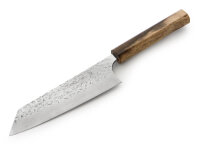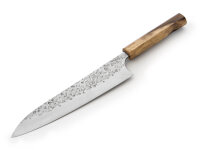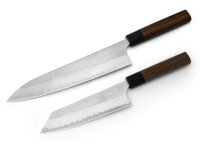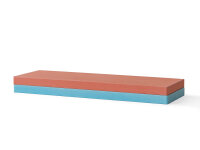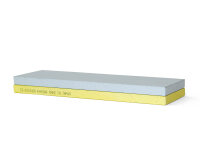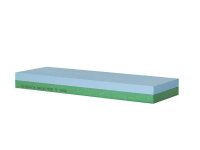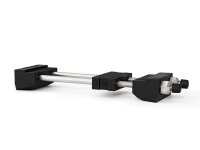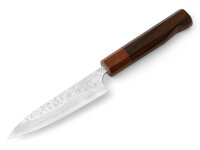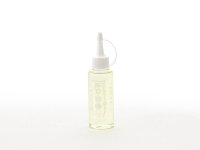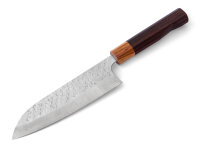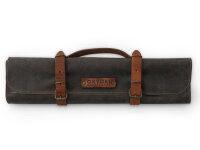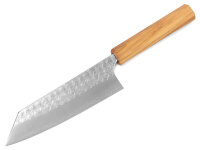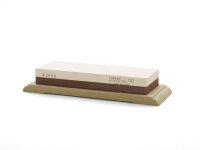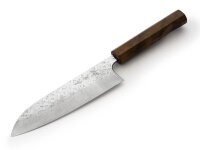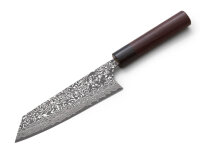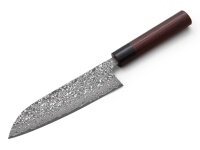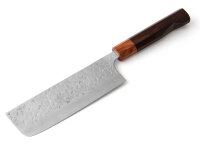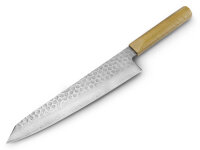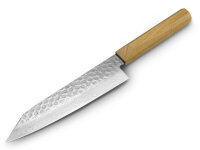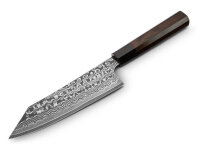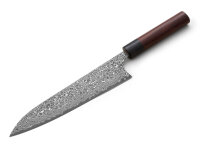"Damascus knife Bunka 170 Rose Ebony, 35 layers"
Hiroshi Kato – A True Master of Japanese Knives
Hiroshi Kato is the second generation blacksmith and knife maker in his family. He mastered the exquisite art of crafting exceptionally high-quality knives from his father, Kintaro Kato. Traditionally, this was the standard route for transferring the skills and "secrets" of the trade. While tradition holds significant importance for Hiroshi Kato, he also embraces change. As a co-founder, he established the knife village of Takefu with other master blacksmiths. Their aim was to preserve ancient knowledge, share experiences, and pass on skills to young blacksmiths. Among these young artisans was Yoshimi Kato, Hiroshi's son and successor, who is now also considered a master in the field. After nearly 60 years of work, Hiroshi Kato has mostly put his forging hammer aside, focusing primarily on quality, innovation, and training. In 2008, Hiroshi Kato received the certificate of traditional craftsmen, a prestigious award that recognises artisanal excellence.
Yoshimi Kato Rose Ebony Knife Series
Material: The Damask Rose Ebony chef's knife series resembles the White Ebony knife series in every aspect except for its handle. This unique handle is crafted from black ebony wood with a ferrule made from Rosewood—a truly harmonious combination. The blade with its special, refined surface finish and unique hammering remains consistent. The blade is composed of 34 layers of Damask steel in two distinct hardness levels, layered alternately around a core made from VG-10 steel. VG-10 is a high-performance Japanese steel, notable for its hardness, impressive flexibility, and corrosion resistance. These knives have exceptional wear resistance and edge retention, and the steel is easily sharpened. The hardness rating (HRC) of the steel stands at 61. Unlike carbon steels like Aogami or Shirogami, VG-10 is a stainless steel containing around 15% chromium. The blade is encased in 16 layers of harder and 18 layers of slightly softer nickel damask, ensuring an optimal balance of hardness, sharpness, and essential flexibility. Finish: Visually, the blade is characterised by its Damask layers, while the upper part is dominated by its hammering. Before hammering the blade, Yoshimi gives the blade surface a particularly fine finish. Tests have shown that the distinct angular style of hammering greatly enhances the non-stick effect for cut materials. Handle: The knife's handle is made of high-quality black ebony. This is why these knives can only be produced in limited quantities. However, it's not just the wood; the handle's shape also has a unique feature. The small indentation near the handle's end provides better grip and optimises knife control. Especially when cutting larger pieces, this design offers greater safety and control over the sharp blade.
Usage Instructions
Japanese chef's knives are crafted from extremely hard steel, thinner in form and sharper than their European counterparts. Some of these knives have very finely honed cutting edges, making them more delicate and suitable primarily for softer materials. Please consider the specific product details regarding this. Knives with very thin edges and hollow grinds can be susceptible to chipping. These are best suited for fine cuts in soft materials, but caution is advised when using them. Typically, sharpening on a whetstone produces a bevelled edge, making the blade more robust over time.
Blade chipping can also result from lever forces or frozen materials, which significantly reduce the steel's temperature. Such forces often come into play when cutting through bone-containing materials. If a blade gets chipped, it may require professional re-sharpening.
Always use the knife with a pulling or pushing cut, applying minimal pressure. To maintain sharpness, avoid cutting on stone, glass, or other hard surfaces. For honing, do not use a honing rod. Instead, use water whetstones (grit: 400-1200 for pre-sharpening, 3000 for fine sharpening, and 6000 or higher for honing), and possibly a leather strop.
Keep the knife away from children. These knives are exceptionally sharp, so please exercise caution.
All products are unique, so slight variations from the illustrative image may occur.
Care Instructions
When using knives made from sensitive steel types, such as Aogami, Shirogami, or V-Toku, periodically clean them with a cloth and water even during extended use. Acidic foods can still cause discolouration on these traditional carbon steels. After use, hand wash with hot water and, if necessary, use a neutral detergent. Never place the knife in a dishwasher. After cleaning, dry thoroughly, oil if needed, and store in a well-ventilated area. Residual moisture can cause rust on non-stainless steels. For more on product care, check our articles in the ORYOKI Japan Blog.
Clean the knife by hand and never use a dishwasher. Always ensure it's dried thoroughly after cleaning.

